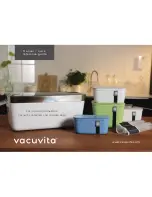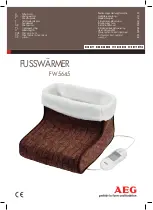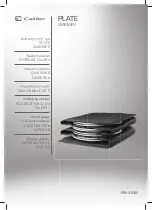
33
DE
EN
FR
IT
NL
ES
CASO VacuChef 50
13.
The sealing time is counted down to 0.
14.
The corresponding LED lights up and turns off when the process is complete.
15.
Open the lid and take out the bag.
16.
Now you can use bag for vacuuming.
PLEASE NOTE
We recommend a break between each vacuuming/ sealing process so that the
sealing bar can cool down. It is, however, also possible to seal several bags one after
another without a break.
Make sure that the bag you want to use is at least
8cm/3.1in.
longer than the food.
Add another
2 cm/0.8in.
for each time the bag is re-used.
Do not overstuff the bag; leave enough empty length in the open end of the bag (at
least a few inches) so that the bag can be properly placed in the vacuum chamber.
Do not wet the open end of the bag. Wet bags may not seal properly.
Clean and straighten the open end of the bag before sealing. Foreign matter or crea-
ses on the bag may result in a faulty seal. Do not wet the open end of the bag. Wet
bags may not seal properly.
If the food you’re sealing has sharp edges (such as bones or shells) pack the edges
with kitchen paper to avoid tearing the bag
First freeze liquid food in a suitable container and then put it in a bag to vacuum seal it.
As food can expand slightly during freezing, choose a bag about 8 cm longer.
Place unfrozen meat or fi sh on a paper towel and vacuum seal with the paper towel
in the bag to absorb any extra moisture.
Separate soft foods that stick together easily with baking or parchment paper and
then vacuum seal them. This will make it easier to remove.
6.6 Sealing a bag without vacuuming it
You can seal a bag without vacuuming it. Insert the bag in the vacuum chamber as
usual and press the “Seal” button. To ensure a cleanly welded seam a short vacuuming
process must be carried out to ensure that the device’s lid is tightly sealed. In the case
of small or full bags this may result in the creation of a vacuum which is too strong. To
solve this problem, simply seal the bag outside the vacuum chamber. To do this, place
the bag over the sealing bar, close the lid and press the “Seal” button.
This works only
with smooth sealed edge bags. If structured bags are used a slight negative pressure
will be created and could result in pressure-sensitive food items being squashed.
6.7 Vacuuming a structured bag outside the vacuum chamber
Structured bags can also be vacuumed outside the vacuum chamber.
To do this, place the bag over the sealing bar and close the lid. Proceed as described
from Step 5 of the “Vacuum packaging a bag in the vacuum chamber” section.
However, this works only with structured bags.
6.8 Vacuum package in a Canister
1.
Place the device on a dry place.
2.
Wipe the vacuum container and its lid to make sure they are clean and dry.
3.
Fill the vacuum goods into the canister. Be careful not to fi ll in too much vacuum
goods.
4.
Close the container with its lid.
5.
Open the device’s lid and remove the air
fi lter and adapter (6a).
6.
Attach one end of the vacuum hose to the
device’s connector (6) and the other end to
the connector on the container lid or use a
corresponding adapter on the container lid.
7.
Set the vacuuming and sealing time as desi-
red.
Make sure that the vacuuming time is
not too long as the container could burst if
the pressure becomes too high.
8.
Press „Vacuum & Seal“.
9.
To ensure there is no air leaking between
the cover and the canister, use your hand to
push down the cover at the beginning of the vacuum operation.
10.
You can stop the process at any time by pressing the “Cancel” button.
11.
Remove the vacuum hose from the cover of container fi rst then from the connector
at device.
PLEASE NOTE
You can also use vacuum zip bags for the vacuuming process. When using zip bags
please note that a corresponding adapter is required for the vacuum hose.
6.9 Marinate
1.
Place the device on a dry place.
2.
Place the food inside the bag.
3.
Open the device’s lid.
4.
Insert the bag into the vacuum chamber as for the vacuuming process.
5.
Press „Marinate“ Button.
6.
Air is removed and automatically reinserted after the vacuuming process. The device
will work for 5 cycles.
7.
The „Marinate“ process ends automatically.
8.
The bag will not be automatically sealed when the “Marinate” process fi nishes. You
can start this manually with the „Seal“ button if necessary.
9.
The device beeps when the operation is completed.
PLEASE NOTE
You can also use vacuum marinating containers for marinating. To do this, follow
steps 1–6 as described in 6.8 and press the „Marinate“ key. The valve in the container
lid must be open. Remove the vacuum hose from the cover of container fi rst then
from the connector at device.
6.10 Opening of a sealed bag
Cut the bag straight across with scissors just inside the seal.
6.11 Storage
Store the device in its upright position, out of the reach of children.
















































